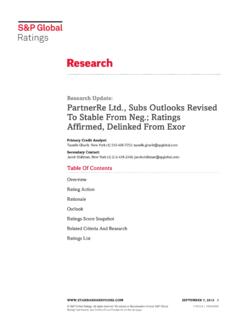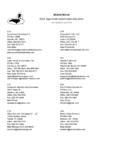Transcription of The Drivers of Catastrophe Bond Pricing - partnerre.com
1 Catastrophe bonds provide a means for investors to achieve returns that are uncorrelated with the broader financial markets. Niraj Patel, ILS Portfolio Manager, PartnerRe, explains how portfolio managers can make more informed decisions around capital allocation by understanding the attributes of Pricing trends. In this paper he provides a comprehensive analysis of Catastrophe bond Pricing over the last 15 years to determine the specific factors and conditions that drive Pricing . The Drivers of Catastrophe Bond PricingPartnerReviews October 2015 Over the last few years, insurance companies have made increasing use of Catastrophe bonds1 to transfer insurance risk to capital markets. The first successful Catastrophe bond was an $85mm issue by Hannover Re in 1994. This was followed by Swiss Re in 1995, Georgetown Re in 1996 and financial services company, USAA s first Residential Re Catastrophe bond in 1997. These early transactions provided investors with an opportunity to assume Catastrophe risk on a securitized basis for the first time.
2 Since then, Catastrophe bonds have evolved into valuable risk management and investment tools by incorporating elements from both the reinsurance and debt capital a ceding company s perspective, Catastrophe bonds operate as a substitute for property Catastrophe reinsurance. More specifically, they provide an alternative means to capitalize a reinsurance transaction. The ceding company purchases reinsurance from a Special Purpose Vehicle (SPV), formed for the sole purpose of entering into a specific transaction; paying the SPV a premium as consideration for the exposure it is ceding. The SPV uses this premium to pay interest to the bond holders providing capital. The capital is invested in high quality collateral and is available should there be losses associated with the reinsurance transaction. Understanding Pricing to understand return From an investor s perspective, the main attraction of Catastrophe bonds is the fact that they provide relatively higher yields on a diversifying asset class.
3 Unlike traditional reinsurance, Catastrophe bonds can be traded on a secondary market, introducing characteristics generally associated with fixed income securities, such as duration, discount margin and yield to maturity. 1 For background on Catastrophe bonds, reader can refer to a number of available primers. One such primer can be accessed at to maturity and credit spreadYield to maturity of a bond is the total yield resulting from all coupon payments and any gains/losses from appreciation/depreciation in the price of the bond an investor achieves upon holding the bond to maturity. This appreciation/depreciation is a result of purchasing a bond at a discount/premium to face value. The yield of a bond can be broken down into two components: risk-free interest rate (government bond yield) and credit spread. The difference between the yield on a bond and the yield on a matched maturity government bond is called the credit spread. Credit spread of a corporate bond is affected by the default risk (expected loss of principal) and the risk premium demanded by investors for taking on this risk.
4 Highly leveraged companies are riskier, implying higher probability of default and therefore, provide higher credit spreads. Thus, lower-rated or below investment-grade corporate bonds (high-yield corporate bonds) provide higher spreads than high-quality investment-grade corporate bonds. In addition to the company specific or idiosyncratic factors, overall economic and business cycles tend to affect credit spreads. A slowing economy tends to widen credit spreads as companies are more likely to default, and a growing economy tends to narrow the spread, as companies are theoretically less likely to default. Finally, risk premium or margin demanded by investors also changes over time and is affected by, among other things, cross-asset relative value considerations and changing perception of risks. The higher the uncertainty associated with risky assets, the higher the risk premium demanded by investors. Note that different market participants may have forward looking views of the expected loss that often differ from each other and from statistically derived historical estimates.
5 Catastrophe bond spreadCatastrophe bonds are issued as floating rate securities, in which the investor receives a set coupon spread over an index (or return on high-quality collateral, which is typically invested in short-term money market funds). The index (or collateral return) is intended to compensate investors for holding their money and is not affected by riskiness of the bond ( embedded insurance risk). It resets periodically based on the prevailing short-term interest rates. The spread of a Catastrophe bond is intended to compensate investors for the insurance risk. Discount margin of a floating-rate bondDiscount margin of a floating-rate bond is the return earned over and above the index underlying the bond. If the bond s price is equal to par (or face value), its discount margin is equal to the coupon spread over index. If the price of the bond is less than par, the discount margin is greater than its coupon spread. This is because of the tendency of the bond price to converge to par as the bond reaches maturity.
6 Thus, an investor can make additional return over the coupon spread for a bond priced at a discount. Conversely, for a premium bond, discount margin is less than the coupon spread. Duration and interest-rate sensitivityDuration is a measure of the sensitivity of the price of a bond to change in interest Catastrophe bonds are floating-rate securities in which the index (or collateral return) resets periodically to prevailing short-term interest rates, the interest-rate sensitivity of Catastrophe bonds is rather low. Corporate bonds, on the other hand, are often fixed-rate bonds, in which the coupon yield is fixed at issuance. Thus, as interest rates change, corporate bond prices change even if nothing else changes. That is, the interest-rate sensitivity of corporate bonds is higher. The Drivers of Catastrophe Bond Pricing continuedThe payment a buyer of reinsurance must make otherwise known as the premium in insurance, or the coupon in bond markets is generally fixed; however, the spread achieved by an investor depends on the price of a bond, as well as its coupon payment stream.
7 Specifically, the spread achieved by investors is inversely related to the price of the bond. Drivers of Catastrophe bond spreadSimilar to other risky bonds, Catastrophe bond spread is a function of modeled expected loss and risk premium. Modeled expected loss, also known as loss cost or average annual loss, is the average value of losses over a full range of scenarios2. The risk premium is the required margin. These two factors drive the spread of a Catastrophe bond. Thus, Catastrophe bond spread is similar to premium or rate on line in the traditional reinsurance market. The risk premium or margin is not constant; rather it is a function of peril zone and modeled expected loss. Moreover, changing perceptions of risk and relative value considerations mean that risk premium changes over time. Note that true underlying value of expected loss is not known; rather modeled expected loss values are just estimates of the true expected loss.
8 This uncertainty in estimating expected loss manifests itself in margin being a function of the expected loss itself. Peak peril zones ( Florida hurricane) typically demand higher margins due to concentrations in investors ILS portfolios compared to diversifying peril zones ( Turkish earthquake). Moreover, given comparable loss costs, the market charges a higher margin for complicated, or less homogeneous risks, such as commercial properties vs. personal lines. Again, this is due to higher uncertainty in estimating expected loss for complex risk, which results in the market demanding higher margin. The risk premium (and therefore, spread) is also influenced by trends across Not to scale. For simplicity, any optionality embedded in the bond (for example a call feature) is not considered October 20152 Catastrophe bonds provide excess of loss (or aggregate excess of loss) reinsurance cover and are similar to securitized products, such as asset-backed securities or mortgage-backed securities.
9 A Catastrophe bond suffers a loss only if a qualifying event results in losses in the subject business that exceed a certain threshold (attachment point). If the subject business losses are high enough to reach the exhaustion point, a Catastrophe bond loses100% of the principal. Expected loss referenced here is based on losses suffered by Catastrophe bonds after taking into account the attachment and exhaustion points, rather than the ground up subject business losses. Breakdown of bond yieldSpreadRisk premiumExpected lossRisk-free rateThe Drivers of Catastrophe Bond Pricing continuedyears, so called soft and hard markets. In a soft market, the cost of coverage drops, while in a hard market it rises. Historically, hard markets have followed years with significant loss activity resulting in depletion of reinsurance capital. Sometimes this increase is localized to a specific area impacted by loss, while at other times it can raise the cost of reinsurance across the entire market.
10 The spread can also shift due to a change in perception of expected loss. For example, during a very active hurricane season or when a hurricane is approaching the coastline, the market perceives a higher probability of loss. In these types of scenarios, the spread widens due to increase in expected loss. Finally, in recent years, broader market trends have had a significant influence on the price of risk (risk premium) and consequently Catastrophe bond spreads. As we will show, spreads can also widen during periods of extreme economic turmoil, unrelated to natural bond spread performance since 2001We now examine historical spread performance of Catastrophe bonds to illustrate its Drivers . Exhibit 1 (below) shows Exhibit 1: Catastrophe bond and high-yield corporate bond spreadsPartnerReviews October 2015 Live cat tradingA hypothetical example to illustrate changing perception of risks is the behavior of a Florida hurricane bond as a category five storm approaches Miami.









![[PUBLISH] IN THE UNITED STATES COURT OF APPEALS FOR …](/cache/preview/0/7/3/4/8/4/4/6/thumb-07348446070f9a9adbdc796d3164ec9c.jpg)


